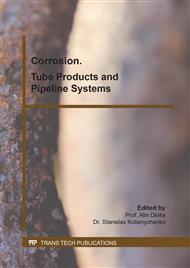p.1218
p.1224
p.1230
p.1235
p.1242
p.1251
p.1257
p.1265
p.1270
Analysis of Corrosion Behavior on External Surface of 110S Tubing
Abstract:
The failure analysis of 110S tubing during acidizing process was addressed. Results showed that serious pitting corrosion occurred on the outer wall of tubing, and there was no obvious pitting on the inner wall. The maximum pitting depth on the outer wall was 1019 μm. According to the results of simulation corrosion test, needle-shaped pitting appeared on the sample surface in the test without inhibitor, the maximum depth of pitting was 158 μm; and no pitting was found on the sample surface in the test within 1.5% TG501 inhibitor; the original pitting were deepened after spent acid test, and the sample with no pitting at the beginning also showed deep pitting corrosion after 96 hours spent acid test. It was indicated that the spent acid accelerated the development of pitting significantly. The external surface corrosion of the 110S tubing was caused by the chemical reaction between the high-concentration acidifying liquid and the outer wall of the tubing. There is a gap between the tubing and coupling threaded connection, which caused the acid solution entered into the thread position, and hence the severe corrosion of the thread and pin end of the tubing happened, the joint strength was continuously reduced with corrosion development till the tripping of the coupling, and then the lower string dropped. Some suggestions were proposed for avoiding or slowing down this kind of failure based on this study.
Info:
Periodical:
Pages:
1242-1250
Citation:
Online since:
May 2020
Authors:
Keywords:
Price:
Сopyright:
© 2020 Trans Tech Publications Ltd. All Rights Reserved
Share:
Citation:



